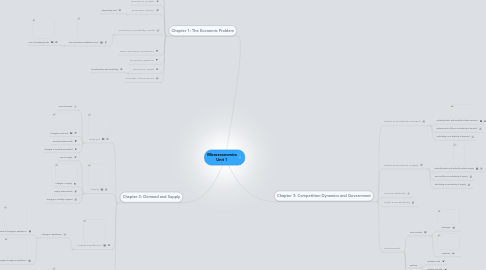
1. Chapter 1: The Economic Problem
1.1. Economics Defined
1.2. The Economic Problem
1.3. Economic Models
1.4. Economic Choice
1.4.1. Opportunity Cost
1.5. Production Possibility Model
1.5.1. The Production Possibilities Curve
1.5.1.1. Law of Increasing Costs
1.6. Basic Economic Questions
1.7. Economic Systems
1.8. Economic Goals
1.8.1. Complimentary and Conflicting
1.9. Founder of Economics
2. Chapter 2: Demand and Supply
2.1. Demand
2.1.1. Law of Demand
2.1.2. Changes in Demand
2.1.3. Demand Determinants
2.1.4. Changes in Quantity Demanded
2.2. Supply
2.2.1. Law of SUpply
2.2.2. Changes in Supply
2.2.3. Supply Determinants
2.2.4. Changes in Quantity Supplied
2.3. Market Equllibrium
2.3.1. Changes in Equilibrium
2.3.1.1. Demand Changes in Equilibrium
2.3.1.2. Supply Changes in Equilibrium
2.4. Utility Maximizing Rule
2.4.1. Utility Maximizing Point
3. Chapter 3: Competition Dynamics and Government
3.1. Elastic and Inelastic Demand
3.1.1. Perfectly Elastic and Perfectly Inelastic Demand
3.1.2. Determinants of the Price Elasticity of Demand
3.1.3. Calculating Price Elasticity of Demand
3.2. Elastic and Inelastic Supply
3.2.1. Perfectly Elastic and Perfectly Inelastic Supply
3.2.2. Time and the Price Elasticity of Supply
3.2.3. Calculating Price Elasticity of Supply
3.3. Income Elasticity
3.4. Cross Price Elasticity
3.5. Government
3.5.1. Price Controls
3.5.1.1. Shortages
3.5.1.2. Surpluses
3.5.2. Spillover
3.5.2.1. Spillover Costs
3.5.2.2. Spillover Benefits
3.5.3. Economic Role of the Government
3.5.4. Taxation
